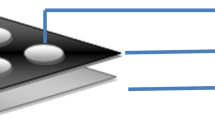Abstract
The preparation of ohmic contacts to heterobipolar nanostructures has a number of characteristic features. In addition to the basic requirement of minimizing contact resistance, contacts to this type of structures have a transition layer whose depth of penetration must not exceed the emitter layer’s thickness, due to the possibility of short-circuiting the emitter base p–n junction. In this work, the effect the main technological parameters of rapid thermal annealing have on a contact’s characteristics are examined, and the process of obtaining a low-resistance ohmic contact to heterobipolar transistor layers is optimized. Ohmic contacts to the n-layers of heterobipolar nanoheterostructures based on gallium arsenide and produced via layer-by-layer electron-beam deposition of Ge/Au/Ni/Au are considered. The diffusion distribution profiles of do** with Ge impurities are calculated as a function of the time and temperature of rapid thermal annealing, and are examined via scanning electron microscopy. It is found that rapid thermal annealing for 60 s at a temperature of 398°C yields ohmic contacts with low resistance, smooth surface morphology, and the minimum size of the transition layer.




Similar content being viewed by others
REFERENCES
A. Iliadis and K. E. Singer, Solid State Commun. 49, 99 (1984).
L. C. Wang, S. S. Lau, E. K. Hsieh, and J. R. Velebir, Appl. Phys. Lett. 54, 2677 (1989).
K. A. Jones, E. H. Linfield, and J. E. F. Frost, Appl. Phys. Lett. 69, 4197 (1996).
T.-J. Kim and P. H. Holloway, Crit. Rev. Solid State Mater. Sci. 22, 239 (1997).
H.-Ch. Lin, S. Senanayake, and K.-Y. Cheng, IEEE Trans. Electron Dev. 50, 880 (2003).
E. J. Koop, M. J. Iqbal, F. Limbach, et al., Semicond. Sci. Technol. 28, 1 (2013).
K. Sarma, J. Appl. Phys. 56, 2703 (1984).
E. Nebauer and M. Trapp, Phys. Status Solidi A 84, 39 (1984).
R. P. Gupta and W. S. Khokle, Solid State Electron. 28, 823 (1985).
V. Egorkin, V. Zemlyakov, A. Nezhentsev, and V. Garmash, Russ. Microelectron. 44, 1 (2017).
M. S. Shur, GaAs Devices and Circuits (Springer Science, New York, 2013).
A. Christou, Solid State Electron. 22, 141 (1979).
ACKNOWLEDGMENTS
This work was supported by the RF Ministry of Education and Science, contract no. 14.578.21.0212, unique identifier RFMEFI57816X0212.
Author information
Authors and Affiliations
Corresponding author
Additional information
Translated by M. Tagirdzhanov
Rights and permissions
About this article
Cite this article
Egorkin, V.I., Zemlyakov, V.E., Nezhentsev, A.V. et al. Investigating the RTA Treatment of Ohmic Contacts to n-Layers of Heterobipolar Nanoheterostructures. Semiconductors 52, 1969–1972 (2018). https://doi.org/10.1134/S1063782618150046
Received:
Accepted:
Published:
Issue Date:
DOI: https://doi.org/10.1134/S1063782618150046




